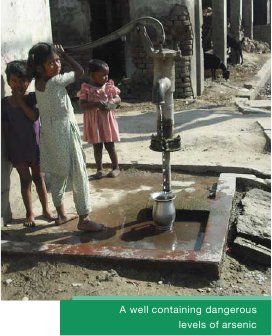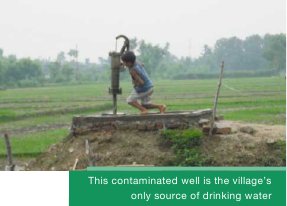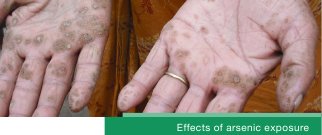Arsenic
Estimated Population At Risk At Identified Sites:
3.7 Million People
Estimated Global Impact:
5 to 9 Million People
Introduction
 Arsenic is a naturally occurring element that is frequently characterized as a metal, despite having properties of both a metal and a nonmetal. In its elemental state, arsenic is a grey solid material; however, arsenic is often found in the environment combined with other elements. These arsenic compounds are generally white or colorless powders that have no smell or taste, making them difficult to detect in food, water, or air.
Arsenic is a naturally occurring element that is frequently characterized as a metal, despite having properties of both a metal and a nonmetal. In its elemental state, arsenic is a grey solid material; however, arsenic is often found in the environment combined with other elements. These arsenic compounds are generally white or colorless powders that have no smell or taste, making them difficult to detect in food, water, or air.
Arsenic is often found in rocks that contain other valuable metals, such as copper and lead. When smelters heat this ore to retrieve the other metals, the arsenic is often released into the air as dust. Arsenic is also found in coal, and can be released through coal-fired power plants or incinerators that burn arsenic-containing products. Arsenic itself is also mined and used in industrial processes. Additionally, about 90% of the arsenic produced each year is used to pressure-treat wood to preserve it and resist rotting and decay. [60] Arsenic is also used in the production of chemical pesticides.
Once arsenic is released into the environment, it attaches to other particles and can easily spread as wind-blown dust. Once in the air, arsenic can stay airborne for many days and travel great distances. Arsenic can also dissolve in water, and thus can easily contaminate lakes, rivers, and ground water resources. Drinking arsenic- contaminated water is a serious health risk to humans. Although organic arsenic can accumulate in some types of fish and shellfish, this form of the element is much less harmful. [61]
Common Exposure Pathways and Health Risks
Arsenic can exist in air, water, soil, or food, and all of these present potential pathways for human exposure. Very low concentrations of arsenic are common in soil; however, in areas within the vicinity of arsenic-rich deposits, the natural concentration of arsenic in soil can increase over a thousand fold. In these areas, it is common to find ground water that is also contaminated with high concentrations of arsenic. For this reason, concentrations of arsenic in ground water are often much higher than those in surface water. This is a particular problem in India, Nepal, and Bangladesh, where naturally occurring arsenic contaminates wells used by millions of people. Arsenic’s ranking in the list of the six top toxic threats is largely due to the number of people affected by naturally occurring arsenic contamination of ground water in South Asia.
 Because of arsenic’s ability to cling to other particles and travel as dust, the inhalation of this element is a common exposure pathway. Workers in the fields of copper and lead smelting, mining, wood treatment, or pesticide application can be exposed to high levels of arsenic in workplace air. Arsenic can also be ingested through food. Seafood is the most common consumption pathway of arsenic, although it can also be found in cereals, mushrooms, and poultry. The arsenic found in most seafood is a type called arsenobetaine, which is less harmful than other forms of the element.
Because of arsenic’s ability to cling to other particles and travel as dust, the inhalation of this element is a common exposure pathway. Workers in the fields of copper and lead smelting, mining, wood treatment, or pesticide application can be exposed to high levels of arsenic in workplace air. Arsenic can also be ingested through food. Seafood is the most common consumption pathway of arsenic, although it can also be found in cereals, mushrooms, and poultry. The arsenic found in most seafood is a type called arsenobetaine, which is less harmful than other forms of the element.
Arsenic has long been recognized as a poison, and large oral doses can cause death. Lower doses of arsenic can cause decreased production of red and white blood cells. One common characteristic effect of arsenic poisoning is visible changes to the skin. People exposed to arsenic often have patches of dark skin, “corns,” and “warts.” Arsenic is also a human carcinogen, and exposure can result in cancer of the liver, bladder, lungs, and skin. [62]
Industrial Sources of Arsenic – Industrial Mining and Smelting
Industry Overview
Industrial mining refers to formal, large-scale mineral extraction operations. Typical minerals extracted at these sites include manganese, copper, tin, lead, nickel, aluminum ore, iron ore, gold, and coal, and the toxicity and value of these materials can range from inert to hazardous, and from common to precious. Smelting refers to the process of heating ores to concentrate and process metals from the ore. Arsenic is found in rocks containing many other elements, and is often released in the process of mining and smelting other metals.
Mining and smelting sites often pose serious risks to local communities, particularly to children. Arsenic cannot be destroyed, and thus remains in surface soil long after the event that released the arsenic has ceased. Because of this, many people do not realize that the soil near them contains high concentrations of the element. Children near mining and smelting sites often interact with soil that carries legacy arsenic pollution from former industrial activities. Children live at ground level, and because of hand-to-mouth behavior can ingest dangerous quantities of arsenic.
Global Context
Industrial mining is a large sector of the global economy. In 2005, the overall value of this mode of mineral extraction was 800 billion USD. From this revenue, 52% came from coal and uranium, 27% came from metals, 14% came from crushed rock, 5% came from industrial minerals, and 2% came from diamonds. [63] Many of these valuable materials are extracted in low- and middle-income countries, primarily those located in South America and Africa.
A frequent pollution problem caused by industrial mines comes from the disposal of mineral wastes. The activities associated with the extraction phase, especially in open-pit mining, typically generate the highest quantities of solid wastes, of which industrial mining has two primary forms: waste rock and tailings. Waste rock is the material removed to access the ore, while tailings are the materials left once the valuable ores are separated from their original sediments in a mineral processing plant. [64] Both forms of waste typically contain the target minerals in low concentrations, as well as other potentially dangerous metals and elements. Additionally, mine waste may also contain toxic residues of chemicals used in the separation process, such as cyanide and mercury.
Exposure Pathways from Mining and Smelting
At some sites, mine wastes are illegally dumped in nearby unprotected piles or waterways. The accumulation of these tailings in riverbeds can cause flooding, which spreads metals, including arsenic, into local farmlands. Furthermore, mine waste rock often generates acid drainage, and when air and water come into contact with metal sulfide minerals, the resulting sulfuric acid solutions can leach into surface and ground water.
 The chemicals often used in the processing of minerals and ore during the extraction phase can leach into nearby surface water and ground water resources. Some mining sites deposit their waste materials in structures meant to protect against migration caused by wind and rain. Yet, once created, these structures can be susceptible to leaks and other damages, thus spilling contaminated tailings into the environment. Many of the elements within these wastes are toxic and present at concentrations that can harm human health. Many of these harmful elements and chemicals occur in both mineral waste repositories and the exposed walls of extraction sites. Mineral-contaminated dust can be transported by wind, taken up by agricultural plants, and can bioaccumulate in the tissues of fish and other food sources. In an Armenian town located near a lead mine, the highest levels of lead were found in dust samples from both inside and outside of homes, indicating the extent to which these materials can be transported into human dwellings. [65]
The chemicals often used in the processing of minerals and ore during the extraction phase can leach into nearby surface water and ground water resources. Some mining sites deposit their waste materials in structures meant to protect against migration caused by wind and rain. Yet, once created, these structures can be susceptible to leaks and other damages, thus spilling contaminated tailings into the environment. Many of the elements within these wastes are toxic and present at concentrations that can harm human health. Many of these harmful elements and chemicals occur in both mineral waste repositories and the exposed walls of extraction sites. Mineral-contaminated dust can be transported by wind, taken up by agricultural plants, and can bioaccumulate in the tissues of fish and other food sources. In an Armenian town located near a lead mine, the highest levels of lead were found in dust samples from both inside and outside of homes, indicating the extent to which these materials can be transported into human dwellings. [65]
Materials such as arsenic, asbestos, and crystalline silica can easily be transmitted via wind, and radioactive minerals from specific extraction sites pose their own set of health risks, explored later in this report. All together, these minerals and metals can enter the human body through a variety of means, including inhalation, dermal absorption, and ingestion of water and food.
What is Being Done
Environmental regulation of industrial mining aims to reduce the risks these operations pose to environmental and human wellbeing. However, the problems posed by industrial mining arise when governments do not have the capacity or will to set strict emission and waste disposal rules, and when these laws fail to be properly enforced. In these cases, some mining companies voluntarily undertake emission reduction programs, most often under pressure from civil society groups.
Blacksmith Institute is working with governments and a range of civil society groups in China, Brazil, Russia, and Chile to both educate community members of potential health risks and initiate a multi-stage cleanup process. Remediation projects often include sealing or removing contaminated soil, isolating and storing legacy tailings with protective lining, and installing spill collection systems, drainage ditches, dams, and temporary containment ponds.
Footnotes
[60] U.S. Department of Health and Human Services. “Toxicological Profile for Arsenic.” Georgia: Agency for Toxic Substances and Disease Registry (2007): 2.
[61] Ibid.
[62] Ibid.
[63] Raw Materials Group, Stockholm 2006.
[64] Superfund Basic Research Program. “Mine Tailings.” The University of Arizona. Available at http://superfund.pharmacy.arizona.edu/Mine_Tailings.php, 2008.
[65] V. Petrosyan, et al. “Lead in Residential Soil and Dust in a Mining and Smelting District in Northern Armenia: A Pilot Study.” Environmental Research 94.3 (2004): 297–308.




